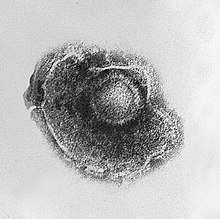
Back Endemies (epidemiologie) Afrikaans مرض وافد Arabic স্থানিক রোগ Bengali/Bangla Endèmia Catalan Endemie Czech Endemie German Endemia Spanish Endeemia Estonian Endemia Basque بیماری بومی Persian

In epidemiology, an infection is said to be endemic in a specific population or populated place when that infection is constantly present, or maintained at a baseline level, without extra infections being brought into the group as a result of travel or similar means.[1] The term describes the distribution (spread) of an infectious disease among a group of people or within a populated area.[2] An endemic disease always has a steady, predictable number of people getting sick, but that number can be high (hyperendemic) or low (hypoendemic), and the disease can be severe or mild.[3][4] Also, a disease that is usually endemic can become epidemic.[3]
For example, chickenpox is endemic (steady state) in the United Kingdom, but malaria is not. Every year, there are a few cases of malaria reported in the UK, but these do not lead to sustained transmission in the population due to the lack of a suitable vector (mosquitoes of the genus Anopheles). Consequently, the number of people infected by malaria in the UK is too variable to be called endemic. However, the number of people who get chickenpox in the UK varies little from year to year, so chickenpox is considered endemic in the UK.
- ^ "Principles of Epidemiology in Public Health Practice, Third Edition An Introduction to Applied Epidemiology and Biostatistics". Centers for Disease Control and Prevention. Retrieved 19 April 2018.
- ^ Cook, Neal; Shepherd, Andrea; Dunleavy, Stephanie; McCauley, Claire (23 April 2022). "Health and Disease in Society". Essentials of Pathophysiology for Nursing Practice. SAGE. pp. 114–115. ISBN 978-1-5297-8581-4.
Terms used to describe distribution include: Endemic: a condition that is generally present in a group or area, such as a cold
- ^ a b Katzourakis A (January 2022). "COVID-19: endemic doesn't mean harmless". Nature. 601 (7894): 485. Bibcode:2022Natur.601..485K. doi:10.1038/d41586-022-00155-x. PMID 35075305. S2CID 246277859.
- ^ Ticona, Eduardo; Gao, George Fu; Zhou, Lei; Burgos, Marcos (13 April 2023). "Person-Centered Infectious Diseases and Pandemics". In Mezzich, Juan E.; Appleyard, James; Glare, Paul; Snaedal, Jon; Wilson, Ruth (eds.). Person Centered Medicine. Springer Nature. p. 465. ISBN 978-3-031-17650-0.
© MMXXIII Rich X Search. We shall prevail. All rights reserved. Rich X Search